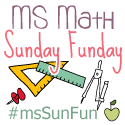This week's #MSsunfun post is about classroom set up. This seems like it is going to be a great set of blogs to follow as it is super interesting to see how other teachers set up their classrooms. I posted about my classroom set up a couple years back. Of course since then, I have moved classrooms twice (and a total of 5 times the past 7 years!) Last year, I was in a classroom and a half as I was also teaching science and needed the extra room. This year I'm back to a regular sized classroom although its shape is a little different than I'm used to because it is at the end of the building not in the middle.
Anyhow, onto how I set up my classroom. Every summer, the custodians take all our furniture out of our classrooms which basically gives us a blank canvas on how to set it back up. (They will put the furniture back as it was, in differently if you ask, etc- the custodians are great!) Last year, when I moved rooms I went from plain old tables to science desks (you know the black ones made heavy wood that fit two kids on a side). If you read this blog, you will know that I learned about Dry Erase paint and decided to make over the science tables. I painted the table tops with this paint which enables kids to write notes, do math problems, draw, etc and also allows me to stop by and while discussing a problem with a student to actually write stuff out. Both the kids and I loved it last year. So, I took the tables with me.
.JPG)
Its looking like I will need all 12 tables as I have class sizes of 24 students again this year (possibly even higher if more people move into the district.) Because my classroom is long and narrowish I decided on doing four groups of three desks. I like to group the desks because most of the work I do has the kids working in groups either of my choosing (or random choosing) or their own choosing. The groupings of three actually should help with discussion and group work. Later in the year, I use a different way of assigning seats (I'll post about it later) but to start the year off I allow students to sit where they choose.
When I set up the desks, I allowed for extra room in front of the Smart board so that I can put a carpet there and work with small groups on certain skills at times during math classes. I also made sure to leave plenty of other spots around the room for groups to go to as I've noticed my 6th graders just LOVE sitting on the floor (well unless we tell them they have to at an assembly.)
I myself don't really use a desk but instead have a long table on which my desk top computer (the one that runs the Smart board) sits along with my ELMO. I figure I spend most of class walking around or sitting with different groups that there isn't much of a reason for me to have a desk. When I'm on my prep break and need to correct, the table works just fine.
I've always tried to put all materials that kids will need together in one spot and this year is no different with me having this nice white cubby set up where I can put dice, playing cards, crayons, staplers, and the like. I make sure to go over this early in the year, telling kids they can use whatever they want but reminding them that they are responsible for picking up after themselves or the stuff won't be there anymore (the whole with rights comes responsibility thing that is so important in middle school.)
.JPG)
The other thing I do is use mailboxes to pass out things like homework, classwork, notes, etc. I find this much easier than passing it out at the beginning of class or having a student in charge of passing stuff out. I make sure early in the year to practice with students what they will do when they enter my room (go to their mailbox, grab EVERYTHING in there) and so it works pretty well. I have three classes and so have three sets of mailboxes. I suppose I could use one and share but I don't really want to rush between classes to put papers into mailboxes (especially if I tier assignments and need to pass out different stuff!)
New to me this year is having raised shelves to put student notebooks. I love this because it gives me more room (as these shelves are right above the mailboxes. Again, I practice with kids getting their notebooks as they enter and we will have to see how these new shelves work.
You probably noticed that my walls are pretty bare. I do have a few math and inspirational posters that I put up but I like to keep most of the wall (and blackboard) available to post student work as the year goes along. I'll include some updated photos throughout the year.
Well, there you have it. That is how my classroom is set up for this year (starting for us in about a week and a half now!)

.JPG)
.JPG)
.JPG)

.JPG)

.JPG)

